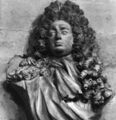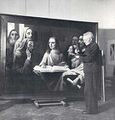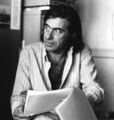Template:Selected anniversaries/October 10: Difference between revisions
No edit summary |
No edit summary |
||
| (29 intermediate revisions by the same user not shown) | |||
| Line 1: | Line 1: | ||
<gallery> | <gallery> | ||
||Bernardino Baldi | ||1617: Bernardino Baldi dies ... mathematician and writer. Pic. | ||
||1629 | ||1629: Richard Towneley born ... mathematician and astronomer. No pics online. | ||
File:Evangelista Torricelli by Lorenzo Lippi.jpg|link=Evangelista Torricelli (nonfiction)|1641: [[Evangelista Torricelli (nonfiction)|Torricelli]] arrives in Arcetri to study with Galileo. ".. postpone his arrival at Arcetri until 10 October 1641. He took up residence in Galileo’s house, where Vincenzo Viviani was already living, and stayed there in close friendship with Galileo until the latter’s death on 8 January 1642. | |||
File:David Gregory.jpg|link=David Gregory (nonfiction)|1708: Mathematician and astronomer [[David Gregory (nonfiction)|David Gregory]] dies. At the Union of 1707, he was given the responsibility of reorganizing the Scottish Mint. | File:David Gregory.jpg|link=David Gregory (nonfiction)|1708: Mathematician and astronomer [[David Gregory (nonfiction)|David Gregory]] dies. At the Union of 1707, he was given the responsibility of reorganizing the Scottish Mint. | ||
File:Henry Cavendish.jpg|link=Henry Cavendish (nonfiction)|1731: Chemist, physicist, and philosopher [[Henry Cavendish (nonfiction)|Henry Cavendish]] born. He will discover "inflammable air", later named hydrogen. | File:Henry Cavendish.jpg|link=Henry Cavendish (nonfiction)|1731: Chemist, physicist, and philosopher [[Henry Cavendish (nonfiction)|Henry Cavendish]] born. He will discover "inflammable air", later named hydrogen. | ||
|| | ||1770: Benjamin Wright born ... engineer who directed the construction of the Erie Canal. A one-time judge, he helped survey the Erie Canal route. When the Erie Canal was finally funded in 1817, Wright was selected as one of the three engineers to design and build it, then named chief engineer. Wright made the Erie Canal project a school of engineering. Until mid-century, almost every civil engineer in the U.S. had trained with, or been trained by someone who had worked under, Wright on the Erie Canal. Because he trained so many engineers on that project, Wright has been called the "father of American civil engineering." He also engaged in the design and construction at the outset of the first railroads. He was the first Chief Engineer of the Erie Railroad. Pic. | ||
|| | ||1837: Charles Fourier dies ... philosopher and academic. Pic. | ||
|| | ||1846: Astronomer William Lassell discovers Triton, the largest moon of the planet Neptune. Pic. | ||
||1861: Fridtjof Nansen born ... explorer, scientist, and humanitarian, Nobel Prize laureate ... Nansen Passport ... Pic. | |||
File:Van meegeren trial.jpg|link=Han van Meegeren (nonfiction)|1889: Painter and forger [[Han van Meegeren (nonfiction)|Han van Meegeren]] born. He will be one of the most ingenious art forgers of the 20th century. | File:Van meegeren trial.jpg|link=Han van Meegeren (nonfiction)|1889: Painter and forger [[Han van Meegeren (nonfiction)|Han van Meegeren]] born. He will be one of the most ingenious art forgers of the 20th century. | ||
||1897 | ||1897: Chemist Felix Hoffmann discovers an improved way of synthesizing acetylsalicylic acid (aspirin). Pic. | ||
||1910: Physicist and chemical engineer Richard Collins Lord born ... a pioneer in the use of infrared radiation for the study of molecular structure and is widely recognized for contributions made to the interpretation of the infrared spectra of molecules in terms of their vibrational motion, and also to our understanding of the cohesion of molecule by means of hydrogen bonding. His studies of the laser Raman spectroscopy of proteins and nucleic acids opened a new field of research. Pic: http://web.mit.edu/spectroscopy/events/lord.html | |||
||1919: Anatole Mallet dies ... mechanical engineer ... inventor of the first successful compound system for a railway steam locomotive, patented in 1874. Pic. | |||
||1919: Arvid Gerhard Damm files for a patent (Swedish patent #52,279) on a rotor machine. No pic online for the man, but yes pic for the machine. | |||
||1924: Pierre Dolbeault born ... mathematician. He will be known for Dolbeault cohomology and the Dolbeault theorem. Pic. | |||
||1925: William Dale Phillips born ... chemist, nuclear magnetic resonance spectroscopist, federal science policy advisor. Pic: https://www.nap.edu/read/9977/chapter/11 and https://academictree.org/chemistry/peopleinfo.php?pid=52514 | |||
||1927: Gustave Whitehead dies ... pilot and engineer. Pic. | |||
|| | ||1929: Elijah J. McCoy dies ... inventor and engineer who was notable for his 57 U.S. patents, most having to do with the lubrication of steam engines. Pic. | ||
|| | ||1930: Yves Chauvin born ... chemist and academic, Nobel Prize laureate for his work from the early 1970s in the area of olefin metathesis. Pic. | ||
|| | ||1936: Gerhard Ertl, German physicist and chemist, Nobel Prize laureate (alive August 2018). | ||
|| | ||1940: David Anthony Klarner born ... mathematician, author, and educator. He is known for his work in combinatorial enumeration, polyominoes, and box-packing. Pic: https://www.flickr.com/photos/thane/421802519 | ||
|| | ||1945: Joseph Darnand dies ... soldier in the French and later German militaries, a leader of the Vichy French collaborators with Nazi Germany and a Waffen-SS officer. Pic. | ||
|| | ||1945: Yuri Razuvaev born ... chess player and trainer. Pic (chess!). | ||
||1949: Chikuhei Nakajima dies ... engineer, businessman, and politician, founded Nakajima Aircraft Company. Pic. | |||
|| | File:Windscale nuclear power plant - Sept 1958.jpg|link=Windscale fire (nonfiction)|1957: [[Windscale fire (nonfiction)|Windscale fire nuclear accident]]: The fire burned for three days and there was a release of radioactive contamination that spread across the UK and Europe. The event was not an isolated incident; there had been a series of radioactive discharges from the piles in the years leading up to the accident. | ||
|File:Chrome Plover early publicity photo.jpg|link=Chrome Plover|1959: [[Chrome Plover]], the famous [[musical electroplating ensemble]], announces new tour. | |File:Chrome Plover early publicity photo.jpg|link=Chrome Plover|1959: [[Chrome Plover]], the famous [[musical electroplating ensemble]], announces new tour. | ||
||1963 | ||1963: France cedes control of the Bizerte naval base to Tunisia. | ||
||1963: The Partial Nuclear Test Ban Treaty comes into effect. | |||
||1964: The opening ceremony of the 1964 Summer Olympics in Tokyo, Japan, is broadcast live in the first Olympic telecast relayed by geostationary satellite. | |||
||1967: The Outer Space Treaty is signed on January 27 by more than sixty nations. | |||
||1971: Cyril Lodowic Burt dies ... educational psychologist and geneticist who made contributions also to statistics. He is known for his studies on the heritability of IQ. Shortly after he died, his studies of inheritance and intelligence were discredited after evidence emerged indicating he had falsified research data. Pic. | |||
||1972: Kenneth Edgeworth dies ... astronomer. Edgeworth is best known for proposing the existence of a disc of bodies beyond the orbit of Neptune in the 1930s- observations later confirmed the existence of the Edgeworth-Kuiper belt in 1992. Today those distant solar system bodies including Pluto, Eris, and Makemake, are grouped into the Edgeworth-Kuiper belt, or Kuiper belt. Pic. | |||
||1975: Norman Levinson dies ... mathematician. Some of his major contributions were in the study of Fourier transforms, complex analysis, non-linear differential equations, number theory, and signal processing. Pic: https://www.gf.org/fellows/all-fellows/norman-levinson/ | |||
|| | ||1979: Heinrich Adolph Louis Behnke dies ... mathematician. Pic. | ||
|| | File:Christopher_Riche_Evans.jpg|link=Christopher Evans (nonfiction)|1979: Psychologist, computer scientist, and author [[Christopher Evans (nonfiction)|Christopher Evans]] dies. | ||
|| | ||1982: Jean Effel dies ... painter, caricaturist, illustrator and journalist. Pic search. | ||
|| | ||1986: Gleb Wataghin dies ... physicist and academic. Pic. | ||
|| | ||1988: Juan Pujol García dies ... Spanish citizen who deliberately became a double agent against Nazi Germany during World War II. He relocated to England to carry out fictional spying activities for the Nazis, and was known by the British codename Garbo and the German codename Alaric Arabel. Pic. | ||
|| | ||1997: Michael J. S. Dewar dies ... American theoretical chemist who developed the Dewar-Chatt-Duncanson model. Dewar is known most famously for the development in the 1970s and 1980s of the Semi-empirical quantum chemistry methods, MINDO, MNDO, AM1 and PM3 that are in the MOPAC computer program, and which for the first time enabled the quantitative study of the structure and mechanism of reaction (transition state) of many real (i.e. large) systems. Pic. | ||
|| | ||1998: Konstantin Petrzhak dies ... nuclear physicist and university professor of Polish origin. He discovered spontaneous fission of uranium with Georgy Flyorov in 1940; in addition, he also aided in Soviet Union's atomic bomb project. Pic. | ||
|| | ||1998: William Markowitz dies ... astronomer, principally known for his work on the standardization of time. Pic: https://aas.org/obituaries/william-markowitz-1907-1998 | ||
|| | ||2007: Karl W. Gruenberg dies ... mathematician who specialized in group theory, in particular with the cohomology theory of groups. Pic. | ||
|| | ||2014: Ichirō Satake dies ... mathematician working on algebraic groups who introduced the Satake isomorphism and Satake diagrams. Pic. | ||
||2015: Richard F. Heck dies ... chemist and academic, Nobel Prize laureate ... noted for the discovery and development of the Heck reaction, which uses palladium to catalyze organic chemical reactions that couple aryl halides with alkenes. Pic. | |||
</gallery> | </gallery> | ||
Latest revision as of 13:21, 7 February 2022
1641: Torricelli arrives in Arcetri to study with Galileo. ".. postpone his arrival at Arcetri until 10 October 1641. He took up residence in Galileo’s house, where Vincenzo Viviani was already living, and stayed there in close friendship with Galileo until the latter’s death on 8 January 1642.
1708: Mathematician and astronomer David Gregory dies. At the Union of 1707, he was given the responsibility of reorganizing the Scottish Mint.
1731: Chemist, physicist, and philosopher Henry Cavendish born. He will discover "inflammable air", later named hydrogen.
1889: Painter and forger Han van Meegeren born. He will be one of the most ingenious art forgers of the 20th century.
1957: Windscale fire nuclear accident: The fire burned for three days and there was a release of radioactive contamination that spread across the UK and Europe. The event was not an isolated incident; there had been a series of radioactive discharges from the piles in the years leading up to the accident.
1979: Psychologist, computer scientist, and author Christopher Evans dies.





